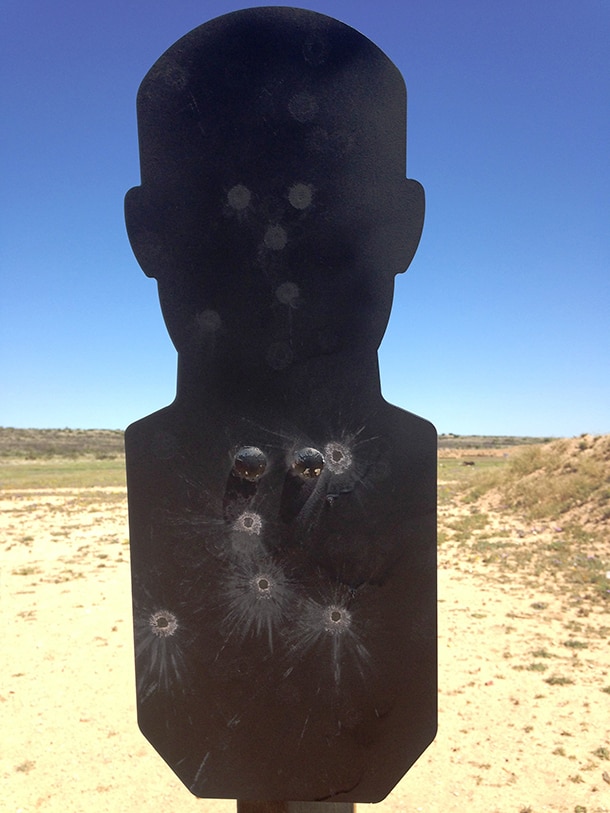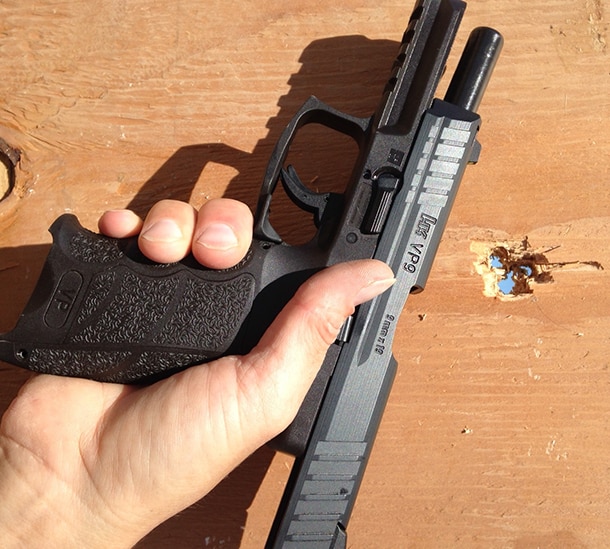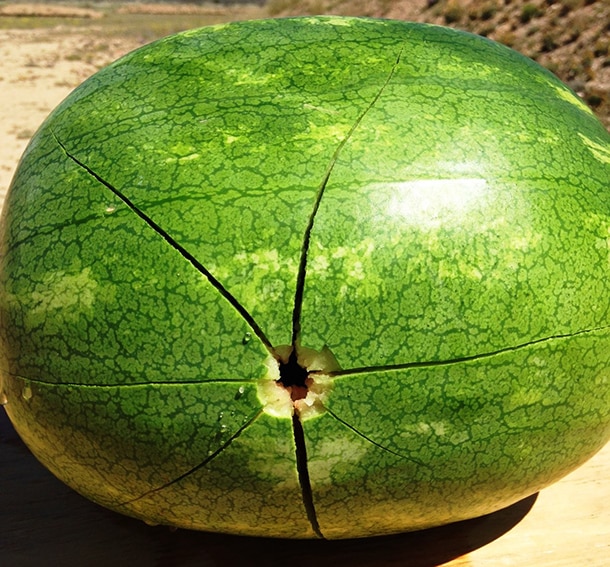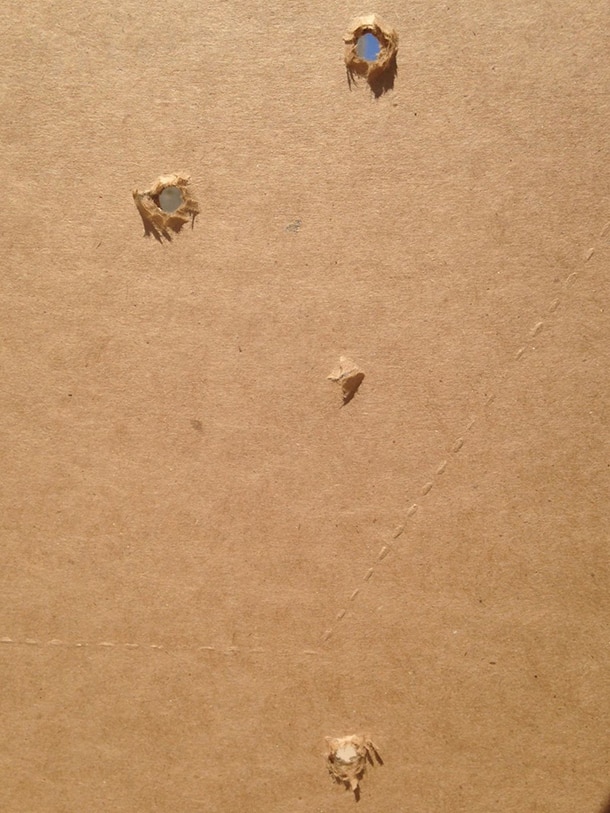
Team Never Quit 9mm, 100 grain HP frangible rounds.
Frangible ammunition, with lead-free bullets, was previously used by this testing team only for building-clearing training, where it’s touted to pulverize on impact with walls, but put a tidy hole through cardboard targets. Today, frangible is being marketed as a worthy alternative to FMJ or HP loads for those concerned with “over-penetration.”
Sounds good, at least according to the ad by-lines. One might imagine using frangible for self-defense if they live in a mobile home, travel in an RV, or want to protect people and things on the other side of interior walls, should a round miss its intended target. But what and how does frangible penetrate, if anything, and can it be useful for self-defense?

For comparison to frangible rounds, we used Atlanta Arms 9mm 115 grain FMJ for this testing session.
This series of unscientific, but practical, tests sought to test the penetrating qualities of this ammo… and the results were quite unexpected. Read to the end, because we found out why.
Lucky Gunner provided Team Never Quit’s 9mm, 100 grain HP frangible for this test. The label claims a 1,250 feet per second muzzle velocity, and disintegration on impact with hard surfaces. This test included four target surfaces: steel, heavy plywood, concrete block and that old range favorite, a fat watermelon. All testing was done using a Heckler & Koch VP9.
Steel
From 15 yards, the marks made on the steel plate by FMJ and frangible were virtually identical. The FMJ in this case was Atlanta Arms’ 115 grain 9mm.

Frangible round marks on steel.

FMJ round marks on steel.
Plywood
Five rounds were fired from five yards, the distance within which most authorities say 55 percent of deadly-force encounters occur. The board was ¾” thick. The tight group isn’t exactly a realistic representation of defensive conditions, of course. The five shots produced a ragged exit hole.

5 rounds at 5 yards, exit plywood.

5 rounds at 15 yards, exit, plywood.

5 rounds at 15 yards frang entrance.
A second group of five rounds was fired from fifteen yards, more than double the 21-foot distance, within which 95 percent of lethal attacks are said to occur. The added distance, or more accurately, shooter error, produced some non-grouped “flyers” and thus a better simulation of defensive shots. ALL rounds on plywood, including the flyers, perforated the board and splintered the back side.
Concrete blocks
Common two-hole construction blocks, previously broken into quarters, were placed atop a table and fired upon from five yards. All eight rounds fired into the blocks penetrated completely, producing small craters on exit. This exercise was repeated from 15 yards on the same blocks, which now bore bullet holes. Substantial breakage and crumbling occurred.

Frangible round, entrance, concrete block.

Team Never Quit frangible round, exit, concrete block.
Watermelon
Mr. Melon had a very rough day as understudy to an actual assailant. When fired upon with a single frangible round from the critical seven-yard distance, this 11-inch thick specimen sustained severe cracks radiating from the entrance “wound,” and a substantial hole on the exit side. The exit wound rapidly bled out onto what is now a very sticky plastic barrel.

Frangible round, entry wound, Mr Melon.

Frangible round, exit wound, Mr. Melon.
The real surprise emerged at the autopsy, though. Mr. Melon was surgically opened by a sharp knife and lengthwise cut, placed well away from the bullet holes so as not to inflict new damage. Inside, the “guts” were severely displaced, with an impressive, softball-sized cavity of material that had been blasted and compressed away from the center.

Mr. Melons mortal wound from a Team Never Quit frangible 9mm round.

Another internal view of Mr. Melon.

Tina fires through plywood into cardboard, 5 rounds at five yards.
Plywood-to-cardboard combo
The last test entailed a shooter poised five yards from a ¾” plywood plank, and five yards behind the plank, a cardboard IDPA target. The shooter fired five non-grouped rounds into the wood. This test was created to see if the round still had any penetrating power after exiting a hard target, having traveled the total distance of, say, two bedrooms. Result: not only did the cardboard have clean bullet holes for every round fired, a few small splinters of plywood also pierced it.

5 rounds at 5 yards, on cardboard target. through plywood. Note the splinters of wood penetrating the target.
“Holy cow!” was uttered more than once during these tests. Assumptions about frangible were shattered along with some of the targets. As Team Never Quit (TNQ) later clarified, the ammo is made to disintegrate when striking a surface harder than itself—which includes solid concrete (like a sidewalk or shoot house), automotive glass, and anything past 15-18 inches of ballistic gel. The reasons are explained below.
Original conclusion: still valid
What we’re left with, other than splintered plywood, crumbled concrete, and mangled melon, is a cautionary tale for anyone who thinks frangible ammo will be a failproof choice for avoiding penetration of walls. While there would surely be minimal damaging power beyond these rounds’ first point of impact, there is still potential for damage from flying debris, and probably from the round itself. People purchasing frangible ammunition for self-defense should not associate this ammunition’s performance with decreased liability….a shooter is responsible for where every round goes.
Second conclusion: with a word from the manufacturer
It seems that FBI ballistic scientists define “over-penetration” a bit differently than one might assume. There are emerging applications for which this ammo is designed. They are, as described by Casey Betzold, President of Snake River Shooting Products and Consulting, Inc., manufacturer for Team Never Quit ammunition:
-
for law enforcement officers, operating in environments where there is elevated risk of collateral damage from ricochet, but still needing to inflict HP-style damage on intended targets. Think 2013 NYPD/Empire State Building incident[ or another in Australia in which a hostage was killed by a ricocheted round that was meant to save her.
-
for shooters who don’t wish to be injured or unwittingly punctured by jacket fragments, a relatively common occurrence, at pistol matches and training events. A video by TNQ shows a shooter and two flankers firing on steel as close as five inches with this ammo—a minimum of 10-12 yards away is the current standard. “Lone Survivor” and former SEAL Marcus Luttrell became motivated to create a safer round after a training incident involving a comrade who was at first unknowingly struck by FMJ fragments in the… well, just watch the video.
Based on the data provided, 9mm frangible HP performs well as a defensive round. Snake River’s testing included 20-gauge steel plus light clothing, over gel. That test achieved eight inches of gel penetration—so our results on less dense materials are no surprise after all.

Based on the data collected during this testing (and this internally eviscerated watermelon), team Never Quit’s 9mm frangible HP performs well as a defensive round and at around $.77 a round, is priced to move.
The price of TNQ 9mm HP frangible is $.775/round at Lucky Gunner. Its nearest competitor, Speer Gold Dot HP, is $.84/round from the same shop. These prices don’t include shipping.
TNQ has set the stage for a whole new view of frangible ammunition. The ability to shoot steel at close distances will allow more new shooters the opportunity to reap the rewards of steel training, and opens up possibilities for other practice applications. In our increasingly liability-obsessed culture, it may offer safeguards for bystanders of LE encounters, with the significant caveat of being defeated by tempered glass. The price is sufficiently less in comparison to other high-grade HP to make it attractive for agencies or individuals who buy in bulk quantities. The company will soon roll out .223 frangible also.
A final note
Thanks and respect to the American producers of both brands involved in this test. In particular, we honor the service of Marcus Luttrell, who lends his legendary reputation and image to Team Never Quit ammunition.
All photos by Team HB.
















